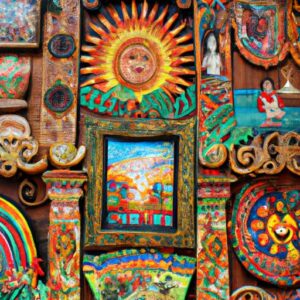Art has always been an integral part of human civilization, expressing our creativity, emotions, and thoughts. Visual arts, in particular, hold a significant place in society, influencing our lives in various ways. In this article, we will explore the importance of visual arts and delve into the profound impact it has on individuals and communities.
A. Importance of Visual Arts in Society
Visual arts transcend cultural boundaries and serve as a universal language that connects people from diverse backgrounds. They have the power to evoke emotions, provoke thoughts, and challenge societal norms. Whether it’s a captivating painting, a breathtaking sculpture, or a thought-provoking photograph, visual arts have a unique ability to communicate complex ideas and narratives.
Artists, through their creations, have the power to shape public opinion, challenge authority, and inspire change. Visual arts provide a platform for social and political commentary, allowing artists to express their thoughts on various issues and initiate conversations that matter. They expose societal injustices, shed light on marginalized voices, and bring attention to critical topics that often go unnoticed.
B. Definition of Visual Arts
Visual arts encompass a wide range of artistic disciplines, including painting, drawing, sculpture, printmaking, photography, digital art, and installation art. These art forms utilize different mediums and techniques to create visually appealing and thought-provoking pieces. Each form of visual art offers a unique perspective and allows the artist to communicate their ideas in distinct ways.
Visual arts not only encompass traditional forms but also embrace contemporary and experimental approaches. In today’s digital age, artists have access to a vast array of tools and technologies that enable them to push boundaries and explore new realms of creativity. From creating immersive virtual reality experiences to blending traditional art techniques with modern digital tools, visual artists continuously redefine what is possible in their craft.
In the following sections, we will delve deeper into the historical significance of visual arts, their evolution over time, and the impact they have on society. Join me on this artistic journey as we explore the fascinating world of visual arts and unravel the reasons why they are truly indispensable.
[To be continued in Historical Significance of Visual Arts]
Historical Significance of Visual Arts
Art has been an integral part of human existence since the earliest civilizations. Throughout history, visual arts have played a pivotal role in capturing the essence of human experiences, reflecting our beliefs, traditions, and aspirations. Let’s explore the historical significance of visual arts and how they have shaped our cultural heritage.
A. Early Human Expression through Visual Arts
From the prehistoric cave paintings in Lascaux to the ancient rock art in Australia, early humans used visual arts as a means of communication and expression. These ancient artworks provide us with glimpses into the lives of our ancestors, documenting their rituals, hunting practices, and spiritual beliefs. Visual arts served as a form of storytelling, allowing early humans to preserve their history and pass down their knowledge through generations.
B. Visual Arts in Ancient Civilizations
Visual arts flourished in ancient civilizations, leaving behind awe-inspiring monuments and artifacts that continue to captivate us to this day. From the grandeur of Egyptian pyramids to the intricate sculptures of Greek gods, ancient civilizations used visual arts to honor their deities, commemorate their rulers, and celebrate their cultural achievements. These artistic creations not only showcased the exceptional craftsmanship of the artists but also served as symbols of power and cultural identity.
C. Renaissance and the Birth of Modern Visual Arts
The Renaissance period marked a significant turning point in the history of visual arts. It was a time of rebirth, rediscovery, and innovation. Artists such as Leonardo da Vinci, Michelangelo, and Raphael emerged during this era, pushing the boundaries of artistic expression and revolutionizing the way we perceive the world. The Renaissance brought about a renewed focus on realism, perspective, and human emotions, leading to groundbreaking advancements in painting, sculpture, and architecture.
The birth of modern visual arts can be attributed to the Renaissance period, as it laid the foundation for artistic movements that followed. From Impressionism to Cubism, Surrealism to Abstract Expressionism, each movement brought forth a new artistic language and challenged traditional norms. These movements not only reflected the social, political, and cultural changes of their respective times but also paved the way for artists to experiment with new techniques, materials, and concepts.
By understanding the historical significance of visual arts, we gain a deeper appreciation for the rich tapestry of human creativity and the ways in which art has shaped our collective identity. In the next section, we will explore the evolution of visual arts and the diverse forms they encompass.
[To be continued in Evolution of Visual Arts]
Evolution of Visual Arts
Visual arts have evolved and transformed over time, embracing new forms, techniques, and mediums. This evolution has given rise to both traditional and contemporary visual arts, each with its own unique characteristics and contributions to the artistic realm.
A. Traditional Visual Arts Forms
1. Painting and Drawing
Painting and drawing are among the oldest and most traditional forms of visual arts. These mediums allow artists to express their creativity, emotions, and observations through the use of lines, colors, and textures. Whether it’s the delicate strokes of a brush on a canvas or the intricate details of a pencil sketch, painting and drawing offer a way to capture moments, ideas, and narratives in a visually captivating manner.
2. Sculpture
Sculpture is another traditional visual art form that involves shaping and manipulating materials to create three-dimensional art pieces. From stone and wood to metal and clay, sculptors use various materials to bring their artistic visions to life. Sculptures can range from small and intricate figurines to large-scale installations, allowing artists to explore form, texture, and space in captivating ways.
3. Printmaking
Printmaking is a traditional technique that involves creating multiple reproductions of an artwork using various methods, such as woodcut, etching, lithography, or screen printing. This art form allows for the mass production of visually striking prints, making art more accessible to a wider audience. Printmaking has played a crucial role in the dissemination of ideas, cultural exchange, and artistic expression throughout history.
B. Contemporary Visual Arts Forms
1. Photography
Photography emerged as a groundbreaking visual art form with the invention of the camera. It allows artists to capture and freeze moments in time, immortalizing them through the lens. Photographers use composition, lighting, and perspective to convey emotions, tell stories, and document the world around them. From breathtaking landscapes to intimate portraits, photography provides a powerful medium for self-expression and visual storytelling.
2. Digital Art
In the digital age, artists have embraced technology as a means of artistic expression. Digital art encompasses a wide range of mediums, including digital painting, computer-generated imagery (CGI), and interactive installations. Artists can manipulate images, experiment with visual effects, and create immersive digital experiences that push the boundaries of traditional art forms.
3. Installation Art
Installation art is an immersive and experiential form of visual art that transforms spaces into captivating and thought-provoking environments. Artists use various materials, objects, and technologies to create installations that engage the senses, challenge perceptions, and evoke emotions. By encouraging audience interaction and exploration, installation art blurs the boundaries between art and life, creating dynamic spaces for reflection and contemplation.
In the next section, we will explore the impact of visual arts on society, delving into the ways it preserves culture, stimulates dialogue, and contributes to personal and societal development.
[To be continued in Impact of Visual Arts on Society]
Impact of Visual Arts on Society
Visual arts play a crucial role in shaping society and leaving a lasting impact on individuals. Let’s explore some key areas where visual arts have a significant influence:
A. Cultural Preservation and Identity
Visual arts serve as a powerful tool for preserving and celebrating cultural heritage. They provide a medium through which traditions, customs, and historical narratives can be visually communicated and passed down to future generations. Artworks such as traditional paintings, sculptures, and crafts often embody the essence of a particular culture, serving as a visual representation of its identity.
Through visual arts, cultural diversity is celebrated, fostering a sense of pride and belonging within communities. Art forms like indigenous paintings, folk dances, and traditional crafts not only preserve cultural heritage but also promote intercultural exchanges, fostering mutual understanding and appreciation among different communities.
B. Social and Political Commentary
Art has long been used as a means of expressing social and political views. Visual arts provide artists with a platform to voice their opinions, challenge societal norms, and raise awareness about pressing issues. Artworks can serve as a catalyst for change, igniting conversations and inspiring action.
Artists often use visual metaphors, symbolism, and powerful imagery to convey their messages. Whether it’s a thought-provoking painting, a powerful street mural, or an interactive installation, visual arts have the ability to provoke emotions, challenge perspectives, and stimulate critical thinking. They act as a mirror to society, reflecting its triumphs, struggles, and aspirations.
C. Education and Personal Development
Visual arts play a vital role in education, nurturing creativity, and promoting holistic development. Art education helps individuals develop essential skills such as problem-solving, critical thinking, and self-expression. Through artistic exploration, individuals learn to observe, analyze, and interpret the world around them, fostering a deeper understanding of themselves and their surroundings.
Engagement with visual arts can also have therapeutic benefits, providing an outlet for emotional expression and promoting mental well-being. Art therapy, for example, utilizes visual arts to help individuals cope with trauma, reduce stress, and enhance self-esteem. The process of creating art allows individuals to tap into their inner thoughts and emotions, leading to personal growth and self-discovery.
In conclusion, the impact of visual arts on society is multifaceted and profound. Whether it’s preserving cultural heritage, sparking social and political dialogue, or nourishing personal development, visual arts have the power to inspire, provoke, and transform. By embracing and appreciating visual arts, we can tap into the immense potential they hold and create a more vibrant and inclusive society.
[To be continued in Psychological Effects of Visual Arts]
Psychological Effects of Visual Arts
Art has a profound impact on our emotions and mental well-being. Visual arts, in particular, have the power to evoke strong emotional responses and provide therapeutic benefits. Let’s explore the psychological effects of engaging with visual arts and how they can enhance our overall cognitive abilities.
A. Emotional Response to Visual Arts
When we encounter a visually captivating piece of art, it has the potential to stir up a range of emotions within us. Whether it’s the vibrant colors of a painting, the intricate details of a sculpture, or the composition of a photograph, visual arts have the ability to elicit joy, sadness, awe, or even a sense of nostalgia. These emotional responses can be deeply personal and subjective, as art taps into our individual experiences and perspectives.
Visual arts allow us to connect with our own emotions and empathize with the emotions expressed by the artist. They provide a safe space for us to explore and process complex feelings that may be difficult to express in words. By engaging with visual arts, we can gain a deeper understanding of ourselves and develop a greater sense of emotional intelligence.
B. Therapeutic Benefits of Art Therapy
Art therapy has gained recognition as a powerful therapeutic tool for individuals facing various mental health challenges. Engaging in visual arts can provide a form of self-expression and a means of communication for those who struggle with verbal expression. Through art therapy, individuals can explore their emotions, improve self-esteem, and develop coping mechanisms.
Art therapy has been proven effective in helping individuals with anxiety, depression, trauma, and other psychological disorders. The act of creating art can be cathartic and healing, allowing individuals to process their emotions in a non-verbal and non-judgmental way. It provides a safe outlet for emotional release and promotes self-reflection and personal growth.
C. Enhancing Cognitive Abilities through Visual Arts
Engaging with visual arts not only impacts our emotions but also enhances our cognitive abilities. Studies have shown that exposure to art can improve critical thinking, problem-solving skills, and creativity. Analyzing and interpreting visual arts requires us to think critically, make connections, and engage in visual reasoning.
Moreover, visual arts stimulate our imagination and encourage divergent thinking, allowing us to explore multiple perspectives and possibilities. By engaging with different art forms and styles, we expand our cultural knowledge, develop a broader worldview, and cultivate a sense of curiosity.
In conclusion, visual arts have a profound impact on our psychological well-being. By evoking emotions, providing therapeutic benefits, and enhancing cognitive abilities, they offer a holistic approach to self-expression and personal growth. The next section will summarize the significance of visual arts and encourage you to explore and appreciate their transformative power.
[To be continued in Conclusion]
Conclusion
In conclusion, the visual arts play a vital role in society, stimulating our senses, challenging our perspectives, and enriching our lives. Through their expressive power, they connect people across cultures, empower marginalized voices, and inspire change.
Visual arts have deep historical roots, tracing back to the earliest human expressions. They have evolved over time, embracing new mediums and techniques that reflect the zeitgeist of each era. From the traditional forms of painting and sculpture to the contemporary realms of digital art and installation art, visual arts continue to captivate and engage audiences.
The impact of visual arts extends beyond mere aesthetics. They serve as a powerful tool for cultural preservation and identity, allowing us to celebrate our heritage and traditions. Visual arts also provide a platform for social and political commentary, shedding light on important issues and sparking conversations for positive change. Moreover, they have therapeutic benefits, aiding in emotional healing, personal development, and cognitive enhancement.
As we navigate through a rapidly changing world, the visual arts remind us of our shared humanity, encouraging empathy, understanding, and appreciation for diverse perspectives. They provide us with a lens to view the world through different eyes, challenging us to question, reflect, and reimagine.
So, why are visual arts important? They are the soul of our society, the mirror that reflects our joys, sorrows, triumphs, and challenges. They inspire us, provoke us, and ignite our imagination. Let us continue to embrace and support the visual arts, for they are not just a form of entertainment, but an essential aspect of our human experience.
Join me in celebrating the visual arts and discover the beauty and power they hold. Explore galleries, museums, and exhibitions, and engage with the artistic creations that surround us. Let the visual arts ignite your curiosity, awaken your emotions, and broaden your perspective. Immerse yourself in this vibrant world, for it is through the visual arts that we truly come alive.
[End of article]





